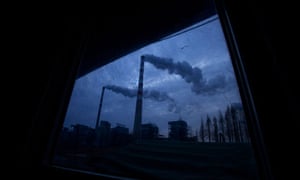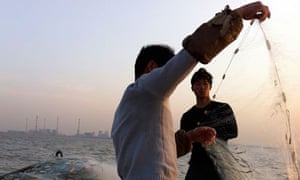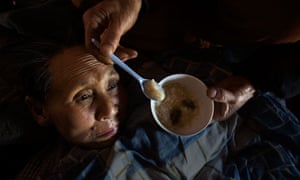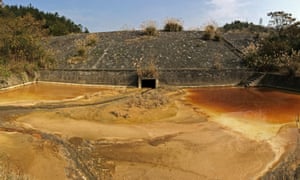Harmful VOCs typically are not acutely toxic, but have compounding long-term health effects.
Because the concentrations are usually low and the symptoms slow to develop, research into VOCs and their effects is difficult.
VOCs in the air, water, and land.
Biologically generated VOCs[edit]
Not counting methane, biological sources emit an estimated 1150 teragrams of carbon per year in the form of VOCs.[15] The majority of VOCs are produced by plants, the main compound being isoprene. The remainder are produced by animals, microbes, and fungi, such as molds.
The strong odor emitted by many plants consists of green leaf volatiles, a subset of VOCs. Emissions are affected by a variety of factors, such as temperature, which determines rates of volatilization and growth, and sunlight, which determines rates of biosynthesis. Emission occurs almost exclusively from the leaves, the stomata in particular. A major class of VOCs is terpenes, such as myrcene. Providing a sense of scale, a forest 62,000 km2 in area (the US state of Pennsylvania) is estimated to emit 3,400,000 kilograms of terpenes on a typical August day during the growing season. VOCs should be a factor in choosing which trees to plant in urban areas.
Anthropogenic sources
Anthropogenic sources emit about 142 teragrams of carbon per year in the form of VOCs.
Specific components
Paints and coatings
A major source of man-made VOCs are coatings, especially paints and protective coatings. Solvents are required to spread a protective or decorative film. Approximately 12 billion litres of paints are produced annually. Typical solvents are aliphatic hydrocarbons, ethyl acetate, glycol ethers, and acetone. Motivated by cost, environmental concerns, and regulation, the paint and coating industries are increasingly shifting toward aqueous solvents.[20]
Chlorofluorocarbons and chlorocarbons
Chlorofluorocarbons, which are banned or highly regulated, were widely used cleaning products and refrigerants. Tetrachloroethene is used widely in dry cleaning and by industry.
Fossil fuels
The use of fossil fuels produces VOC's either directly as products (e.g., gasoline) or indirectly as byproducts (e.g., automobile exhaust gas).[citation needed]
Benzene
Main article: Benzene
One VOC that is a known human carcinogen is benzene, which is a chemical found in environmental tobacco smoke, stored fuels, and exhaust from cars. Benzene also has natural sources such as volcanoes and forest fires. It is frequently used to make other chemicals in the production of plastics, resins, and synthetic fibers. Benzene evaporates into the air quickly and the vapor of benzene is heavier than air allowing the compound to sink into low-lying areas. Benzene has also been known to contaminate food and water and if digested can lead to vomiting, dizziness, sleepiness, rapid heartbeat, and at high levels, even death may occur.[citation needed]
Methylene chloride
Methylene chloride can be found in adhesive removers and aerosol spray paints. In the human body, methylene chloride is metabolized to carbon monoxide. If a product that contains methylene chloride needs to be used the best way to protect human health is to use the product outdoors. If it must be used indoors, proper ventilation will help to keep exposure levels down.[citation needed] In the United States, methylene chloride is listed as exempt from VOC status.
Perchloroethylene
Perchloroethylene is a volatile organic compound that has been linked to causing cancer in animals. It is also suspected to cause many of the breathing related symptoms of exposure to VOCs.[citation needed] Perchloroethylene is used mostly in dry cleaning. While dry cleaners recapture perchloroethylene in the dry cleaning process to reuse it, some environmental release is unavoidable.
MTBE
MTBE was banned in certain states within the US around 2004 in order to limit further contamination of drinking water aquifers (groundwater) primarily from leaking underground gasoline storage tanks where MTBE was used as an octane booster and oxygenated-additive.[citation needed]
Formaldehyde
Many building materials such as paints, adhesives, wall boards, and ceiling tiles slowly emit formaldehyde, which irritates the mucous membranes and can make a person irritated and uncomfortable. Formaldehyde emissions from wood are in the range of 0.02–0.04 ppm. Relative humidity within an indoor environment can also affect the emissions of formaldehyde. High relative humidity and high temperatures allow more vaporization of formaldehyde from wood-materials.
Indoor air
Main article: Indoor air quality
Since many people spend much of their time indoors, long-term exposure to VOCs in the indoor environment can contribute to sick building syndrome. In offices, VOC results from new furnishings, wall coverings, and office equipment such as photocopy machines, which can off-gas VOCs into the air. Good ventilation and air-conditioning systems are helpful at reducing VOCs in the indoor environment. Studies also show that relative leukemia and lymphoma can increase through prolonged exposure of VOCs in the indoor environment.
In the United States, there are two standardized methods for measuring VOCs, one by the National Institute for Occupational Safety and Health (NIOSH) and another by OSHA. Each method uses a single component solvent; butanol and hexane cannot be sampled, however, on the same sample matrix using the NIOSH or OSHA method.
The aromatic VOC compound benzene, emitted from exhaled cigarette smoke, is labeled as carcinogenic and is ten times higher in smokers than in nonsmokers.
EPA has found concentrations of VOCs in indoor air to be 2 to 5 times greater than in outdoor air and sometimes far greater.[14] During certain activities indoor levels of VOCs may reach 1,000 times that of the outside air. Studies have shown that individual VOC emissions by themselves are not that high in an indoor environment, but the indoor total VOC (TVOC) concentrations can be up to five times higher than the VOC outdoor levels.[29] New buildings especially, contribute to the highest level of VOC off-gassing in an indoor environment because of the abundant new materials generating VOC particles at the same time in such a short time period. In addition to new buildings, we also use many consumer products that emit VOC compounds, therefore the total concentration of VOC levels is much greater within the indoor environment.
VOC concentration in an indoor environment during winter is three to four times higher than the VOC concentrations during the summer. High indoor VOC levels are attributed to the low rates of air exchange between the indoor and outdoor environment as a result of tight-shut windows and the increasing use of humidifiers.
Indoor air quality measurements
Measurement of VOCs from the indoor air is done with sorption tubes e. g. Tenax® (for VOCs and SVOCs) or DNPH-cartridges (for carbonyl-compounds). The VOCs adsorb on these materials and are afterwards desorbed either thermally (Tenax®) or by elution (DNPH) and then analyzed by GC-MS/FID or HPLC. Reference gas mixtures are required for quality control of these VOC-measurements.[32] Furthermore, VOC emitting products used indoors, e. g. building products and furniture, are investigated in emission test chambers under controlled climatic conditions.[33] For quality control of these measurements round robin tests are carried out, therefore reproducibly emitting reference materials are ideally required.
Regulation of indoor VOC emissions
In most countries, a separate definition of VOCs is used with regard to indoor air quality that comprises each organic chemical compound that can be measured as follows: Adsorption from air on Tenax TA, thermal desorption, gas chromatographic separation over a 100% nonpolar column (dimethylpolysiloxane). VOC (volatile organic compounds) are all compounds that appear in the gas chromatogram between and including n-hexane and n-hexadecane. Compounds appearing earlier are called VVOC (very volatile organic compounds); compounds appearing later are called SVOC (semi-volatile organic compounds). See also these standards: ISO 16000-6, ISO 13999-2, VDI 4300-6, German AgBB evaluating scheme, German DIBt approval scheme, GEV testing method for the EMICODE. Some overviews over VOC emissions rating schemes[34] have been collected and compared.
France, Germany and Belgium have enacted regulations to limit VOC emissions from commercial products, and industry has developed numerous voluntary ecolabels and rating systems, such as EMICODE, M1, Blue Angel and Indoor Air Comfort[38] In the United States, several standards exist; California Standard CDPH Section 01350[39] is the most popular one. Over the last few decades, these regulations and standards changed the marketplace, leading to an increasing number of low-emitting products: The leading voluntary labels report that licenses to several hundreds of low-emitting products have been issued (see the respective webpages such as MAS Certified Green.- Certified Products).
Health risks
Respiratory, allergic, or immune effects in infants or children are associated with man-made VOCs and other indoor or outdoor air pollutants.
Some VOCs, such as styrene and limonene, can react with nitrogen oxides or with ozone to produce new oxidation products and secondary aerosols, which can cause sensory irritation symptoms. Unspecified VOCs are important in the creation of smog.
Health effects include eye, nose, and throat irritation; headaches, loss of coordination, nausea; and damage to the liver, kidney, and central nervous system. Some organics can cause cancer in animals; some are suspected or known to cause cancer in humans. Key signs or symptoms associated with exposure to VOCs include conjunctival irritation, nose and throat discomfort, headache, allergic skin reaction, dyspnea, declines in serum cholinesterase levels, nausea, vomiting, nose bleeding, fatigue, dizziness.[citation needed]
The ability of organic chemicals to cause health effects varies greatly from those that are highly toxic, to those with no known health effects. As with other pollutants, the extent and nature of the health effect will depend on many factors including level of exposure and length of time exposed. Eye and respiratory tract irritation, headaches, dizziness, visual disorders, and memory impairment are among the immediate symptoms that some people have experienced soon after exposure to some organics. At present, not much is known about what health effects occur from the levels of organics usually found in homes. Many organic compounds are known to cause cancer in animals; some are suspected of causing, or are known to cause, cancer in humans.
https://en.wikipedia.org/wiki/Volatile_organic_compound
Because the concentrations are usually low and the symptoms slow to develop, research into VOCs and their effects is difficult.
VOCs in the air, water, and land.
Biologically generated VOCs[edit]
Not counting methane, biological sources emit an estimated 1150 teragrams of carbon per year in the form of VOCs.[15] The majority of VOCs are produced by plants, the main compound being isoprene. The remainder are produced by animals, microbes, and fungi, such as molds.
The strong odor emitted by many plants consists of green leaf volatiles, a subset of VOCs. Emissions are affected by a variety of factors, such as temperature, which determines rates of volatilization and growth, and sunlight, which determines rates of biosynthesis. Emission occurs almost exclusively from the leaves, the stomata in particular. A major class of VOCs is terpenes, such as myrcene. Providing a sense of scale, a forest 62,000 km2 in area (the US state of Pennsylvania) is estimated to emit 3,400,000 kilograms of terpenes on a typical August day during the growing season. VOCs should be a factor in choosing which trees to plant in urban areas.
Anthropogenic sources
Anthropogenic sources emit about 142 teragrams of carbon per year in the form of VOCs.
Specific components
Paints and coatings
A major source of man-made VOCs are coatings, especially paints and protective coatings. Solvents are required to spread a protective or decorative film. Approximately 12 billion litres of paints are produced annually. Typical solvents are aliphatic hydrocarbons, ethyl acetate, glycol ethers, and acetone. Motivated by cost, environmental concerns, and regulation, the paint and coating industries are increasingly shifting toward aqueous solvents.[20]
Chlorofluorocarbons and chlorocarbons
Chlorofluorocarbons, which are banned or highly regulated, were widely used cleaning products and refrigerants. Tetrachloroethene is used widely in dry cleaning and by industry.
Fossil fuels
The use of fossil fuels produces VOC's either directly as products (e.g., gasoline) or indirectly as byproducts (e.g., automobile exhaust gas).[citation needed]
Benzene
Main article: Benzene
One VOC that is a known human carcinogen is benzene, which is a chemical found in environmental tobacco smoke, stored fuels, and exhaust from cars. Benzene also has natural sources such as volcanoes and forest fires. It is frequently used to make other chemicals in the production of plastics, resins, and synthetic fibers. Benzene evaporates into the air quickly and the vapor of benzene is heavier than air allowing the compound to sink into low-lying areas. Benzene has also been known to contaminate food and water and if digested can lead to vomiting, dizziness, sleepiness, rapid heartbeat, and at high levels, even death may occur.[citation needed]
Methylene chloride
Methylene chloride can be found in adhesive removers and aerosol spray paints. In the human body, methylene chloride is metabolized to carbon monoxide. If a product that contains methylene chloride needs to be used the best way to protect human health is to use the product outdoors. If it must be used indoors, proper ventilation will help to keep exposure levels down.[citation needed] In the United States, methylene chloride is listed as exempt from VOC status.
Perchloroethylene
Perchloroethylene is a volatile organic compound that has been linked to causing cancer in animals. It is also suspected to cause many of the breathing related symptoms of exposure to VOCs.[citation needed] Perchloroethylene is used mostly in dry cleaning. While dry cleaners recapture perchloroethylene in the dry cleaning process to reuse it, some environmental release is unavoidable.
MTBE
MTBE was banned in certain states within the US around 2004 in order to limit further contamination of drinking water aquifers (groundwater) primarily from leaking underground gasoline storage tanks where MTBE was used as an octane booster and oxygenated-additive.[citation needed]
Formaldehyde
Many building materials such as paints, adhesives, wall boards, and ceiling tiles slowly emit formaldehyde, which irritates the mucous membranes and can make a person irritated and uncomfortable. Formaldehyde emissions from wood are in the range of 0.02–0.04 ppm. Relative humidity within an indoor environment can also affect the emissions of formaldehyde. High relative humidity and high temperatures allow more vaporization of formaldehyde from wood-materials.
Indoor air
Main article: Indoor air quality
Since many people spend much of their time indoors, long-term exposure to VOCs in the indoor environment can contribute to sick building syndrome. In offices, VOC results from new furnishings, wall coverings, and office equipment such as photocopy machines, which can off-gas VOCs into the air. Good ventilation and air-conditioning systems are helpful at reducing VOCs in the indoor environment. Studies also show that relative leukemia and lymphoma can increase through prolonged exposure of VOCs in the indoor environment.
In the United States, there are two standardized methods for measuring VOCs, one by the National Institute for Occupational Safety and Health (NIOSH) and another by OSHA. Each method uses a single component solvent; butanol and hexane cannot be sampled, however, on the same sample matrix using the NIOSH or OSHA method.
The aromatic VOC compound benzene, emitted from exhaled cigarette smoke, is labeled as carcinogenic and is ten times higher in smokers than in nonsmokers.
EPA has found concentrations of VOCs in indoor air to be 2 to 5 times greater than in outdoor air and sometimes far greater.[14] During certain activities indoor levels of VOCs may reach 1,000 times that of the outside air. Studies have shown that individual VOC emissions by themselves are not that high in an indoor environment, but the indoor total VOC (TVOC) concentrations can be up to five times higher than the VOC outdoor levels.[29] New buildings especially, contribute to the highest level of VOC off-gassing in an indoor environment because of the abundant new materials generating VOC particles at the same time in such a short time period. In addition to new buildings, we also use many consumer products that emit VOC compounds, therefore the total concentration of VOC levels is much greater within the indoor environment.
VOC concentration in an indoor environment during winter is three to four times higher than the VOC concentrations during the summer. High indoor VOC levels are attributed to the low rates of air exchange between the indoor and outdoor environment as a result of tight-shut windows and the increasing use of humidifiers.
Indoor air quality measurements
Measurement of VOCs from the indoor air is done with sorption tubes e. g. Tenax® (for VOCs and SVOCs) or DNPH-cartridges (for carbonyl-compounds). The VOCs adsorb on these materials and are afterwards desorbed either thermally (Tenax®) or by elution (DNPH) and then analyzed by GC-MS/FID or HPLC. Reference gas mixtures are required for quality control of these VOC-measurements.[32] Furthermore, VOC emitting products used indoors, e. g. building products and furniture, are investigated in emission test chambers under controlled climatic conditions.[33] For quality control of these measurements round robin tests are carried out, therefore reproducibly emitting reference materials are ideally required.
Regulation of indoor VOC emissions
In most countries, a separate definition of VOCs is used with regard to indoor air quality that comprises each organic chemical compound that can be measured as follows: Adsorption from air on Tenax TA, thermal desorption, gas chromatographic separation over a 100% nonpolar column (dimethylpolysiloxane). VOC (volatile organic compounds) are all compounds that appear in the gas chromatogram between and including n-hexane and n-hexadecane. Compounds appearing earlier are called VVOC (very volatile organic compounds); compounds appearing later are called SVOC (semi-volatile organic compounds). See also these standards: ISO 16000-6, ISO 13999-2, VDI 4300-6, German AgBB evaluating scheme, German DIBt approval scheme, GEV testing method for the EMICODE. Some overviews over VOC emissions rating schemes[34] have been collected and compared.
France, Germany and Belgium have enacted regulations to limit VOC emissions from commercial products, and industry has developed numerous voluntary ecolabels and rating systems, such as EMICODE, M1, Blue Angel and Indoor Air Comfort[38] In the United States, several standards exist; California Standard CDPH Section 01350[39] is the most popular one. Over the last few decades, these regulations and standards changed the marketplace, leading to an increasing number of low-emitting products: The leading voluntary labels report that licenses to several hundreds of low-emitting products have been issued (see the respective webpages such as MAS Certified Green.- Certified Products).
Health risks
Respiratory, allergic, or immune effects in infants or children are associated with man-made VOCs and other indoor or outdoor air pollutants.
Some VOCs, such as styrene and limonene, can react with nitrogen oxides or with ozone to produce new oxidation products and secondary aerosols, which can cause sensory irritation symptoms. Unspecified VOCs are important in the creation of smog.
Health effects include eye, nose, and throat irritation; headaches, loss of coordination, nausea; and damage to the liver, kidney, and central nervous system. Some organics can cause cancer in animals; some are suspected or known to cause cancer in humans. Key signs or symptoms associated with exposure to VOCs include conjunctival irritation, nose and throat discomfort, headache, allergic skin reaction, dyspnea, declines in serum cholinesterase levels, nausea, vomiting, nose bleeding, fatigue, dizziness.[citation needed]
The ability of organic chemicals to cause health effects varies greatly from those that are highly toxic, to those with no known health effects. As with other pollutants, the extent and nature of the health effect will depend on many factors including level of exposure and length of time exposed. Eye and respiratory tract irritation, headaches, dizziness, visual disorders, and memory impairment are among the immediate symptoms that some people have experienced soon after exposure to some organics. At present, not much is known about what health effects occur from the levels of organics usually found in homes. Many organic compounds are known to cause cancer in animals; some are suspected of causing, or are known to cause, cancer in humans.
https://en.wikipedia.org/wiki/Volatile_organic_compound




